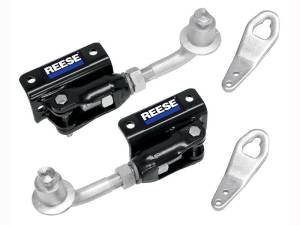- Home »
- Catalog »
- Towing & Trailer Equipment »
- Hitches »
- Hitch Accessories »
- Sway Control Kit
PitStopUSA.com - Sway Control Kit

Used to reduce trailer sway and improve handling in adverse towing conditions.
This patented product is the premier method for controlling trailer sway. Unlike the friction sway control, this approach works to control sway from the start rather than just resisting sway once it's begun. And it works only when needed.
When towing in a straight line, the cams on either side of the trailers A-frame are locked in position. This essentially creates a "rigid" connection between tow vehicle and trailer and minimizes the effects of induced sway caused by high crosswinds or passing vehicles. Usually the cams ride in a detent, locked-in position, even on fairly sharp curves. However, when cornering maneuvers are required, the cams automatically slide out of their detent to permit full radius turns. Yet when the maneuver is short and abrupt, like that encountered in the event of a sudden swerve or a wheel dropping off the road, the cams seek a straight-line towing angle that helps the tow vehicle retain control.
The advantage of the Dual Cam system is its ability to forestall sway in addition to sway resistance. It works to hold down the start of swaying activity while at the same time allowing free and easy vehicle and trailer interaction. Another advantage of the Dual Cam system is that it's installed on the trailer and therefore doesn't require adjustment every time the towing vehicle and trailer are hooked up, unless hitch weight or tow vehicle loading are changed.
More About Sway Control Kit
Used to reduce trailer sway and improve handling in adverse towing conditions.
This patented product is the premier method for controlling trailer sway. Unlike the friction sway control, this approach works to control sway from the start rather than just resisting sway once it's begun. And it works only when needed.
When towing in a straight line, the cams on either side of the trailers A-frame are locked in position. This essentially creates a "rigid" connection between tow vehicle and trailer and minimizes the effects of induced sway caused by high crosswinds or passing vehicles. Usually the cams ride in a detent, locked-in position, even on fairly sharp curves. However, when cornering maneuvers are required, the cams automatically slide out of their detent to permit full radius turns. Yet when the maneuver is short and abrupt, like that encountered in the event of a sudden swerve or a wheel dropping off the road, the cams seek a straight-line towing angle that helps the tow vehicle retain control.
The advantage of the Dual Cam system is its ability to forestall sway in addition to sway resistance. It works to hold down the start of swaying activity while at the same time allowing free and easy vehicle and trailer interaction. Another advantage of the Dual Cam system is that it's installed on the trailer and therefore doesn't require adjustment every time the towing vehicle and trailer are hooked up, unless hitch weight or tow vehicle loading are changed.


